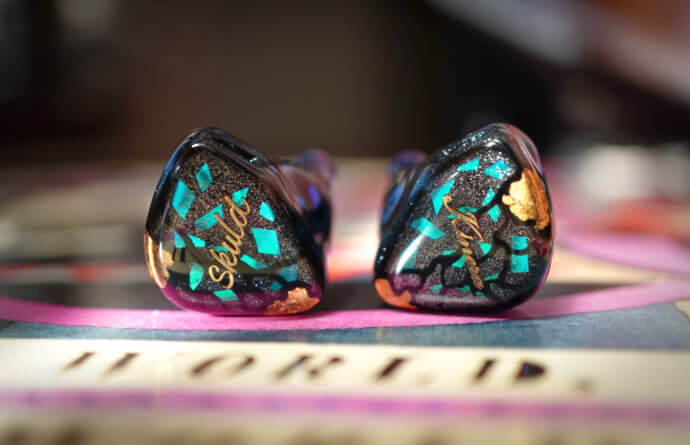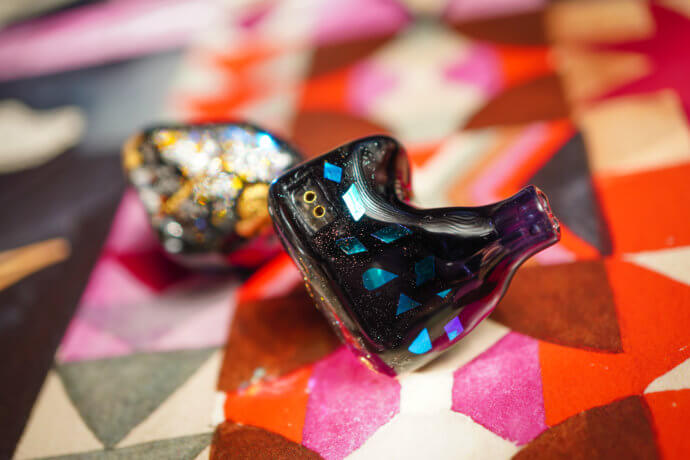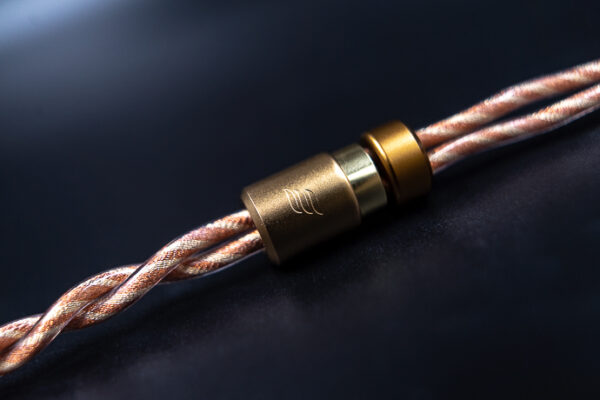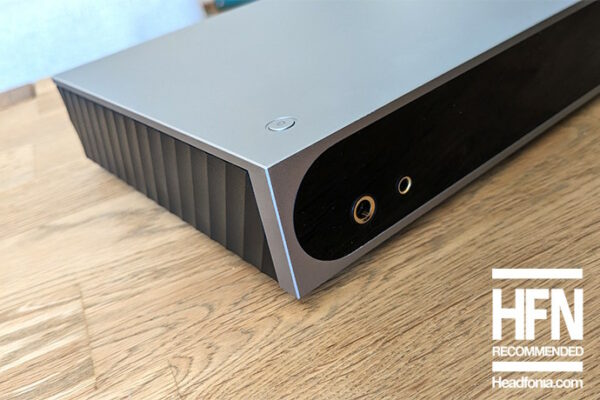Sound quality and performance
Out of the box, the Skuld immediately reveals itself to have an extremely balanced, somewhat typical balance-armature tone that emphasises clarity, technicalities and nuance over dynamic heft and force-fed detail. The Skuld will definitely feel on the ‘leaner’ side of the tonal equation if you’re used to a single or hybrid dynamic-driver IEM, but further listening reveals that the strength of the Skuld lies in a linear, mature voicing that delivers intriguing and addictive mid-range detail, along with impressive speed and transient-handling abilities. Instrument, and in particular vocal detail is the star of the show here, and you behind to appreciate with further listening that the Skuld’s wonderful mid-range tone isn’t impeded by a messy or forthright low-end, and is backed-up by a nicely restrained upper treble that neatly balances detail and extension while avoiding sibilance and excessive ‘hotness’.
The Skuld isn’t exactly a bass-head’s delight when it comes to low-end extension and impact. It’ll certainly give you all the sense of the deep sub-bass notes in Nicolas Jaar’s ‘Colomb’, but it’s doing so with dexterity and speed rather than with out-and-out ‘slam’. Listen for a few more tracks and you become quickly accustomed to the Skuld’s bass characteristics, and I was thankful for how linear and fast its low-end presentation is, and for not intruding into the rest of the mix.
The Skuld is without question a mid-range lover’s delight. It does a terrific job with acoustic guitar tone and detail and gives a fantastic sense of ‘being there’, especially with live performances. Chris Cornell (R.I.P) had one of the best set of pipes in the business and listening to his live album ‘Songbook’ with the Skuld is an absolute treat. The Skuld does extremely well at rendering male vocals, giving you a real ‘front row’ sense of the microscopic textures and emotions in every note.

I mentioned earlier that the Skuld’s treble was nicely restrained, however, I did find that it does tend a have a little extra energy just 10Hz that can occasionally sound a little brittle when male singers hit high notes, and cymbals can also sound a little splashy at times. I found that this was generally pronounced when listening to poorer, compressed recordings and wasn’t really evident in well recorded and mastered tracks. When listening to John Mayer ‘Clarity’, I was super impressed by how well the Skuld was able to separate and project the distinct guitar and vocal parts at the start of the track, but things get a little more congested and intense when it starts to ‘rock out’ some. That’s more of a criticism of the track than the Skuld, damn the loudness wars.
The excellent imaging and reasonably wide staging, combined with the excellent clarity of the Skuld is able to surgically pull-apart small details inside songs, and create a well-defined sense of space around individual tracks, such as the excellently-produced ‘Soothing’ by Laura Marling. Do note that the Skuld gives you spades of insight, even when you’re not looking for it – they’re a revealing IEM, and they won’t smooth out imperfections.
Tip-rolling proved interesting with the Skuld, with the four different supplied types of tips each offering subtle tweaks to its sound, in addition to comfort and fit. The wider-bore Custom RS-B4S and JH-FY009-B silicone tips both adding a little more treble extension and clarity, but both also provide a little added forwardness with female vocals. This is nicely tamed with both the foam and Final Type E tips, which also add a slight degree of welcome mid-bass warmth – I settled with the Final tips as my preferred ‘sweet spot’ for the Skuld.
Powering and pairing
At 23 ohms impedance and 120dB sensitivity, the Skuld is extremely easy to drive and requires only the tiniest skerrick of voltage to get very loud, very quickly – my Samsung S9+ got AC/DC’s ‘Back in Black’ to rock-out levels at less than 25% on the volume dial. Switching over to a dedicated player in the Astell&Kern SR25, the Skuld proves that it’ll scale up nicely when fed with a high-quality source, with bass definition, treble clarity, and overall separation improving markedly. Using the SR25’s 2.5mm balanced output, I never needed to go beyond ‘30’ out of its total 150 stepped volume increments. Pleasingly, despite being super easy to drive there wasn’t a hint of hiss nor background noise to be had. To test its noise floor a bit further, I plugged the Skuld into the balanced output of the Schiit Jotunheim 2 desktop amp, which packs a whole 7.5 Watts of power into 16 ohms. While this might seem a little ‘overkill’, there wasn’t a hint of noise until the Jotunheim’s volume pot was turned up past 12 o’clock in low gain – more than enough to blow up the little Kinera IEMs. I actually spent quite a bit of time with the Skuld powered off the Bifrost 2/Jotunheim 2 desktop rig, which was a bloody tasty pairing – albeit it with the volume wheel kept extremely low for safety. This didn’t extract any magical performance that a DAP won’t yield, but it was terrific to have the convenience factor of connecting with my desktop rig and library, as well as the knowledge that the Skuld won’t turn into a noisy beast with a full-size headphone amp.

The SR25’s bigger brother, the twin-DAC-ced SE200, is an absolute class-act of a portable player and turned out to be a stellar pairing with the technically adept Skuld. The revealing nature and superb imaging chops of the Skuld were able to extract a thoroughly immersive and downright out-of-head experience from the SE200 – listening to ‘Unless’ by Atoms For Peace, I genuinely forgot that I was listening to a pair of IEMs rather than a pair of open-back headphones.

Vs FiiO FH5
The $250 USD FH5 from FiiO might be a hybrid design but as a solid and well-known multi-driver/mid-tier offering, it was an interesting benchmark to compare the Skuld against. The FH5 feels immediately more extended at either end compared to the more linear and balanced Skuld, which makes it feel initially more ‘wow’ in terms of excitement and engagement. The biggest difference between the two is the less forward lower treble in the FH5, which feels almost ‘scooped’ compared to the front-and-centre detail out on display with the Skuld. This has the effect of making male vocals, in particular, feel a little more distant and less realistic, whilst also giving them a slight ‘breath-y’ characteristic. The FH5 also has a more immediate sense of staging that doesn’t have the width or depth of the Skuld, which reminds you that you’re listening to a rendering of music through an IEM, rather than getting out of the way and making you forget that you’re actually wearing them, which can be the case with the Skuld. The dynamic driver in the FH5 certainly brings a degree more bass and warmth to the party, but it doesn’t manage the transition into the mid-range as neatly and coherently as the Kinera.

Vs Oriveti OH500
The OH500 is another hybrid design, using a 4xBA plus single dynamic driver set-up, but at $500 it presents an interesting alternative to the similarly-priced, all-BA Skuld. The OH500 has a distinctly warmer, more lush sound than the Skuld courtesy of a more distinct sub-bass presence that gives a more ‘snug’ sensation when listening to bass-heavy music. There are more distinct peaks throughout the mid-range and treble on the Oriveti which do detract a little from it sounding entirely natural at times due to its tendency to make vocals sound a little strident. Some consonant sounds and plosives can be a little too emphasised with the OH500, while the Skuld’s more even-handed approach gives a more believable sense to vocals and instrumental parts.

Vs Campfire Polaris II
The $499 USD Polaris II from Campfire Audio is virtually the spiritual opposite of the Skuld in terms of how it goes about playing music. It has a looming, omnipresent bass that totally dominates proceedings and feeling positively dark in the vocal and treble department after listening to the detail-focused, linear approach of the Skuld. That 9.2mm dynamic woofer in the Polaris II certainly creates far more dynamic low-end impact, and overall creates a more ‘house party’ sort of tone, compared to the more restrained Skuld, which feels more like a live performance from a well-rehearsed 5-piece jazz ensemble, by comparison. Despite sounding somewhat ‘veiled’ in the upper registers, the Polaris II also somehow manages to also have a metallic, ‘tizzy’ and artificial tone in the upper air department which again creates a less balanced and believable tone that takes you out of the musical experience.

Final thoughts
Kinera has created a super compelling proposition for those looking to take a step up in the IEM world and treat themselves to both a more ‘grown-up’ tone as well as an exemplary design and product experience. While beauty is certainly in the eye of the beholder, the design of the Skuld is simply gorgeous in this reviewer’s opinion, and you’re getting a superbly well-crafted and accessorized IEM for $550 USD. Sonically, the Skuld delivers upon Kinera’s stated mission to create balance – it’s a voicing that’ll appeal to lovers of mid-range detail and tone, as well as a more neutral and technically adept approach to sound. Lovers of a warm or lush tone would be best suited to audition it first, but there’s plenty of impressive technicalities to help overcome what you might initially perceive as shortfalls, and potentially even convert you to a more neutral, linear sound signature.








Alex
Hello! I want to become a music producer and i’m aiming at an iem neutral, precise which tells me with criticism what truly there is in the track; i have seen the skuld frequency response graph and i ask you: “can the skuld be defined a real studio monitor? Are they balanced and neutral enough to be defined as a true studio monitor for music producing and mastering?
Matty Graham
I’m no studio professional, so please take my advice with a grain of salt. The Skuld is pretty revealing and faithful to the source, so I could imagine it being a good ‘tool’ in that sense.
Adam
Great review Matty. I now love a balanced IEM, which I only discovered after listening to the Polaris II one day which was just too much bass for me. Gave me a headache! I may have to try the Skuld.
We’re all waiting for Matty podcast style reviews strolling and rolling round Bondi bowling club, that would be fantastic!
Matty Graham
Happy to loan them to you mate! Let’s catch up for a beer at the bowlo…when we’re allowed to again.